Economics Report: Analysis of Inflation, Trade, and Fiscal Policies
VerifiedAdded on 2023/06/04
|10
|2030
|212
Report
AI Summary
This economics report provides a comprehensive analysis of key macroeconomic concepts. It begins by defining inflation, differentiating between demand-pull and cost-push inflation, and explaining the role of monetary and fiscal policies in controlling it. The report then delves into international trade, discussing restrictive trade practices such as tariffs and quotas, and exploring the arguments for and against such restrictions, with the U.S.-China trade war as a case study. Finally, the report examines fiscal policies in detail, explaining expansionary and contractionary measures, their impact on the economy, and illustrating these concepts using the AS-AD model. The report uses graphs and figures to explain the concepts. It also provides various references to support the arguments and analysis. The report provides a clear understanding of the concepts covered.
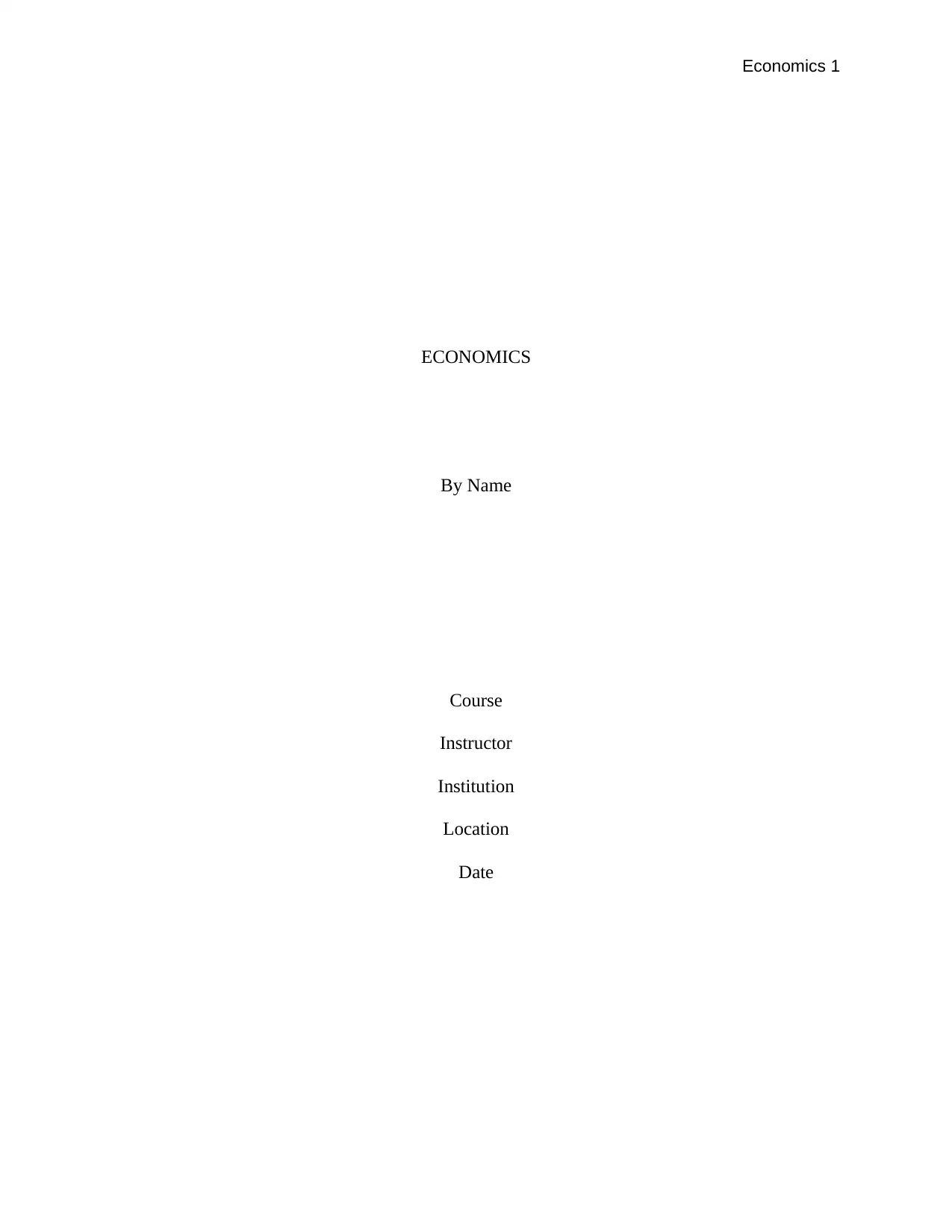
Economics 1
ECONOMICS
By Name
Course
Instructor
Institution
Location
Date
ECONOMICS
By Name
Course
Instructor
Institution
Location
Date
Paraphrase This Document
Need a fresh take? Get an instant paraphrase of this document with our AI Paraphraser

Economics 2
Q1
Inflation is the persistent rise in general levels of prices leading to a decline in purchasing
power. The level of inflation in a country is measured using the retail price index (RPI) which
measures change in average price of a unit of goods and services that represent the consumption
pattern of a typical household RPI valid (Ball, 2017). Demand-pull inflation occurs when
aggregate demand in the economy is more than the aggregate supply. The increasing costs of
production pushes price levels higher. Demand-pull inflation occurs when value of aggregate
demand exceeds that of output at full employment.
Figure 1
From the graph above, aggregate demand rises from AD1 to AD2 leading to a price
increase from P1 to P2. The impact of this type inflation is that, too much money will be chasing
Q1
Inflation is the persistent rise in general levels of prices leading to a decline in purchasing
power. The level of inflation in a country is measured using the retail price index (RPI) which
measures change in average price of a unit of goods and services that represent the consumption
pattern of a typical household RPI valid (Ball, 2017). Demand-pull inflation occurs when
aggregate demand in the economy is more than the aggregate supply. The increasing costs of
production pushes price levels higher. Demand-pull inflation occurs when value of aggregate
demand exceeds that of output at full employment.
Figure 1
From the graph above, aggregate demand rises from AD1 to AD2 leading to a price
increase from P1 to P2. The impact of this type inflation is that, too much money will be chasing
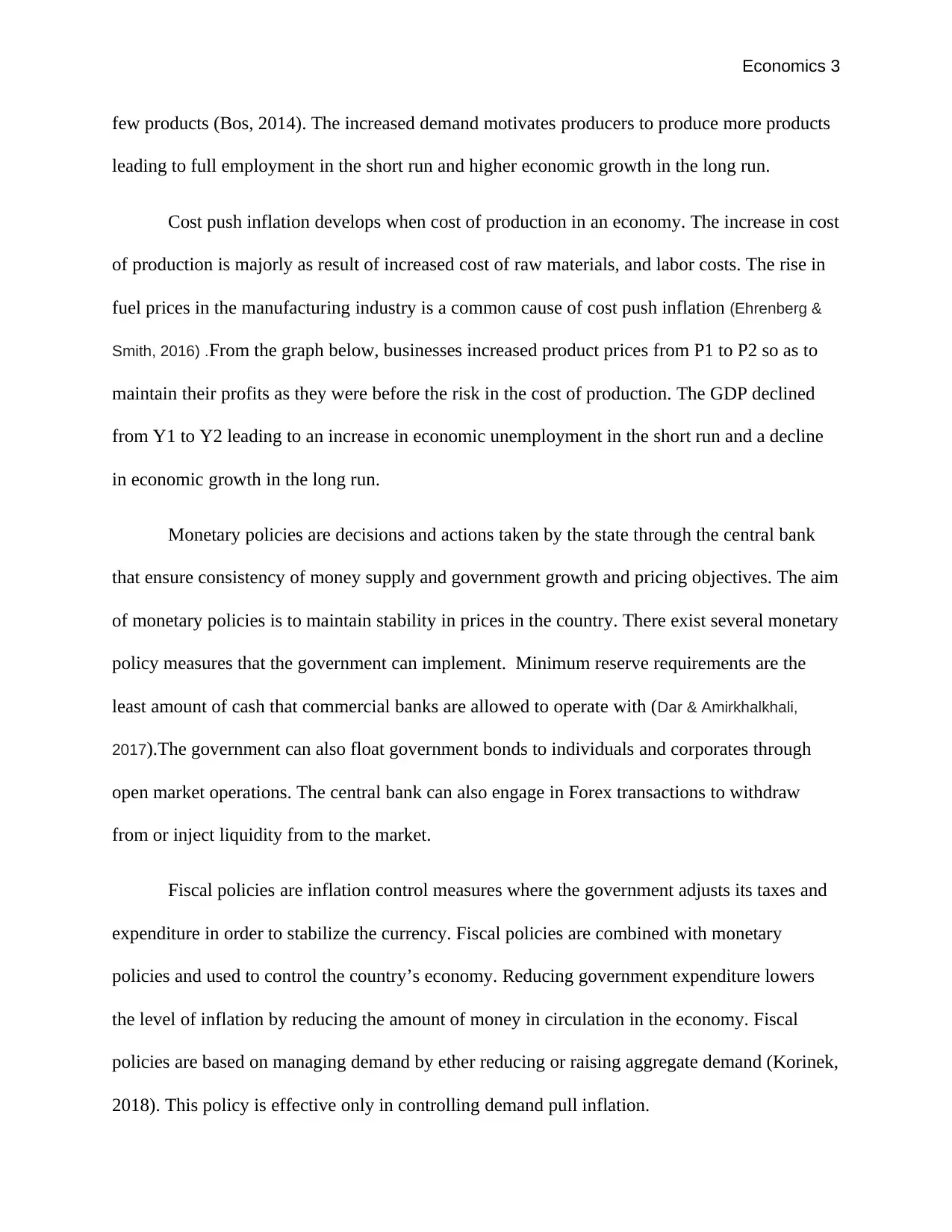
Economics 3
few products (Bos, 2014). The increased demand motivates producers to produce more products
leading to full employment in the short run and higher economic growth in the long run.
Cost push inflation develops when cost of production in an economy. The increase in cost
of production is majorly as result of increased cost of raw materials, and labor costs. The rise in
fuel prices in the manufacturing industry is a common cause of cost push inflation (Ehrenberg &
Smith, 2016) .From the graph below, businesses increased product prices from P1 to P2 so as to
maintain their profits as they were before the risk in the cost of production. The GDP declined
from Y1 to Y2 leading to an increase in economic unemployment in the short run and a decline
in economic growth in the long run.
Monetary policies are decisions and actions taken by the state through the central bank
that ensure consistency of money supply and government growth and pricing objectives. The aim
of monetary policies is to maintain stability in prices in the country. There exist several monetary
policy measures that the government can implement. Minimum reserve requirements are the
least amount of cash that commercial banks are allowed to operate with (Dar & Amirkhalkhali,
2017).The government can also float government bonds to individuals and corporates through
open market operations. The central bank can also engage in Forex transactions to withdraw
from or inject liquidity from to the market.
Fiscal policies are inflation control measures where the government adjusts its taxes and
expenditure in order to stabilize the currency. Fiscal policies are combined with monetary
policies and used to control the country’s economy. Reducing government expenditure lowers
the level of inflation by reducing the amount of money in circulation in the economy. Fiscal
policies are based on managing demand by ether reducing or raising aggregate demand (Korinek,
2018). This policy is effective only in controlling demand pull inflation.
few products (Bos, 2014). The increased demand motivates producers to produce more products
leading to full employment in the short run and higher economic growth in the long run.
Cost push inflation develops when cost of production in an economy. The increase in cost
of production is majorly as result of increased cost of raw materials, and labor costs. The rise in
fuel prices in the manufacturing industry is a common cause of cost push inflation (Ehrenberg &
Smith, 2016) .From the graph below, businesses increased product prices from P1 to P2 so as to
maintain their profits as they were before the risk in the cost of production. The GDP declined
from Y1 to Y2 leading to an increase in economic unemployment in the short run and a decline
in economic growth in the long run.
Monetary policies are decisions and actions taken by the state through the central bank
that ensure consistency of money supply and government growth and pricing objectives. The aim
of monetary policies is to maintain stability in prices in the country. There exist several monetary
policy measures that the government can implement. Minimum reserve requirements are the
least amount of cash that commercial banks are allowed to operate with (Dar & Amirkhalkhali,
2017).The government can also float government bonds to individuals and corporates through
open market operations. The central bank can also engage in Forex transactions to withdraw
from or inject liquidity from to the market.
Fiscal policies are inflation control measures where the government adjusts its taxes and
expenditure in order to stabilize the currency. Fiscal policies are combined with monetary
policies and used to control the country’s economy. Reducing government expenditure lowers
the level of inflation by reducing the amount of money in circulation in the economy. Fiscal
policies are based on managing demand by ether reducing or raising aggregate demand (Korinek,
2018). This policy is effective only in controlling demand pull inflation.
⊘ This is a preview!⊘
Do you want full access?
Subscribe today to unlock all pages.

Trusted by 1+ million students worldwide

Economics 4
Q2
Restrictive trade
International trade is the exchange of goods and services across country borders.
International trade might be limited by trade restrictions. Restrictive trade is achieved through
the imposition of tariffs and quotas on imports (Miller & Benjamin, 2017).Tariffs are taxes imposed
on each unit of product imported. It raises prices of imported products such that locally produced
goods become cheaper and more affordable for local consumers. Quotas on the other hand limits
quantity of a product imported by placing a ceiling in amount of imports. Countries can
implement quotas by limiting imports licenses and placing a maximum amount on total imports.
Classical economists preferred free trade among countries. However, trade restrictions have now
become common in international trade. Recently, the United States of America imposed tariffs
on import of steel and furniture from China which China retaliated by imposing tariffs on some
American products. The United States levied a 10% import tariff on Chinese products worth
$200 billion. The goods include furniture and electrical appliances. In response, China imposed
taxes on around 5,207American products of around $60 billion.
Reasons for restrictive trade
Restrictive trade protects infant local producers from foreign dominance. Young local
companies with high chance of success once established are protected from competition until
they gain strength to compete internationally. This argument is common in the manufacturing
industry majorly in developing nations since they attempt to replace foreign imports with locally
produced goods so as to achieve balance of payments.
Q2
Restrictive trade
International trade is the exchange of goods and services across country borders.
International trade might be limited by trade restrictions. Restrictive trade is achieved through
the imposition of tariffs and quotas on imports (Miller & Benjamin, 2017).Tariffs are taxes imposed
on each unit of product imported. It raises prices of imported products such that locally produced
goods become cheaper and more affordable for local consumers. Quotas on the other hand limits
quantity of a product imported by placing a ceiling in amount of imports. Countries can
implement quotas by limiting imports licenses and placing a maximum amount on total imports.
Classical economists preferred free trade among countries. However, trade restrictions have now
become common in international trade. Recently, the United States of America imposed tariffs
on import of steel and furniture from China which China retaliated by imposing tariffs on some
American products. The United States levied a 10% import tariff on Chinese products worth
$200 billion. The goods include furniture and electrical appliances. In response, China imposed
taxes on around 5,207American products of around $60 billion.
Reasons for restrictive trade
Restrictive trade protects infant local producers from foreign dominance. Young local
companies with high chance of success once established are protected from competition until
they gain strength to compete internationally. This argument is common in the manufacturing
industry majorly in developing nations since they attempt to replace foreign imports with locally
produced goods so as to achieve balance of payments.
Paraphrase This Document
Need a fresh take? Get an instant paraphrase of this document with our AI Paraphraser
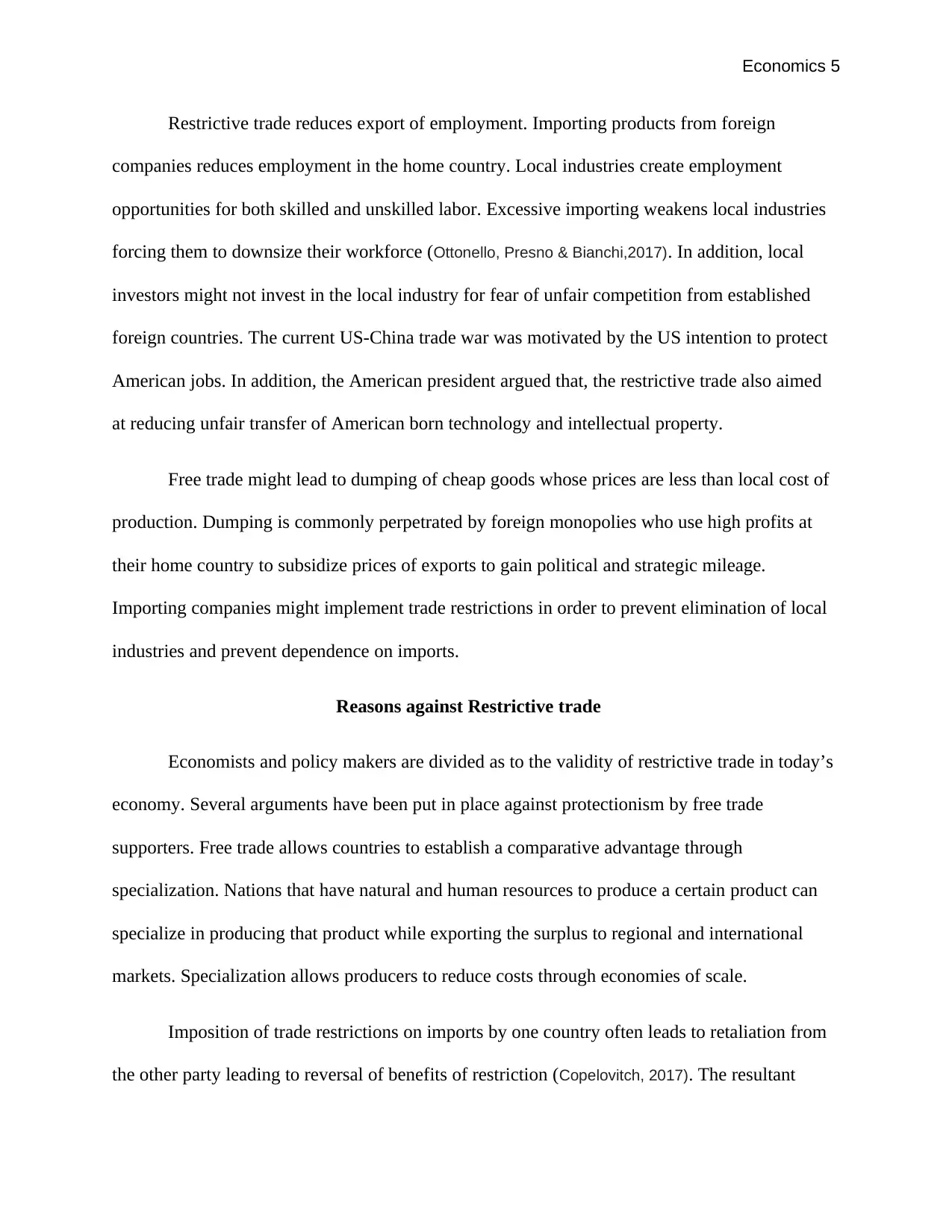
Economics 5
Restrictive trade reduces export of employment. Importing products from foreign
companies reduces employment in the home country. Local industries create employment
opportunities for both skilled and unskilled labor. Excessive importing weakens local industries
forcing them to downsize their workforce (Ottonello, Presno & Bianchi,2017). In addition, local
investors might not invest in the local industry for fear of unfair competition from established
foreign countries. The current US-China trade war was motivated by the US intention to protect
American jobs. In addition, the American president argued that, the restrictive trade also aimed
at reducing unfair transfer of American born technology and intellectual property.
Free trade might lead to dumping of cheap goods whose prices are less than local cost of
production. Dumping is commonly perpetrated by foreign monopolies who use high profits at
their home country to subsidize prices of exports to gain political and strategic mileage.
Importing companies might implement trade restrictions in order to prevent elimination of local
industries and prevent dependence on imports.
Reasons against Restrictive trade
Economists and policy makers are divided as to the validity of restrictive trade in today’s
economy. Several arguments have been put in place against protectionism by free trade
supporters. Free trade allows countries to establish a comparative advantage through
specialization. Nations that have natural and human resources to produce a certain product can
specialize in producing that product while exporting the surplus to regional and international
markets. Specialization allows producers to reduce costs through economies of scale.
Imposition of trade restrictions on imports by one country often leads to retaliation from
the other party leading to reversal of benefits of restriction (Copelovitch, 2017). The resultant
Restrictive trade reduces export of employment. Importing products from foreign
companies reduces employment in the home country. Local industries create employment
opportunities for both skilled and unskilled labor. Excessive importing weakens local industries
forcing them to downsize their workforce (Ottonello, Presno & Bianchi,2017). In addition, local
investors might not invest in the local industry for fear of unfair competition from established
foreign countries. The current US-China trade war was motivated by the US intention to protect
American jobs. In addition, the American president argued that, the restrictive trade also aimed
at reducing unfair transfer of American born technology and intellectual property.
Free trade might lead to dumping of cheap goods whose prices are less than local cost of
production. Dumping is commonly perpetrated by foreign monopolies who use high profits at
their home country to subsidize prices of exports to gain political and strategic mileage.
Importing companies might implement trade restrictions in order to prevent elimination of local
industries and prevent dependence on imports.
Reasons against Restrictive trade
Economists and policy makers are divided as to the validity of restrictive trade in today’s
economy. Several arguments have been put in place against protectionism by free trade
supporters. Free trade allows countries to establish a comparative advantage through
specialization. Nations that have natural and human resources to produce a certain product can
specialize in producing that product while exporting the surplus to regional and international
markets. Specialization allows producers to reduce costs through economies of scale.
Imposition of trade restrictions on imports by one country often leads to retaliation from
the other party leading to reversal of benefits of restriction (Copelovitch, 2017). The resultant
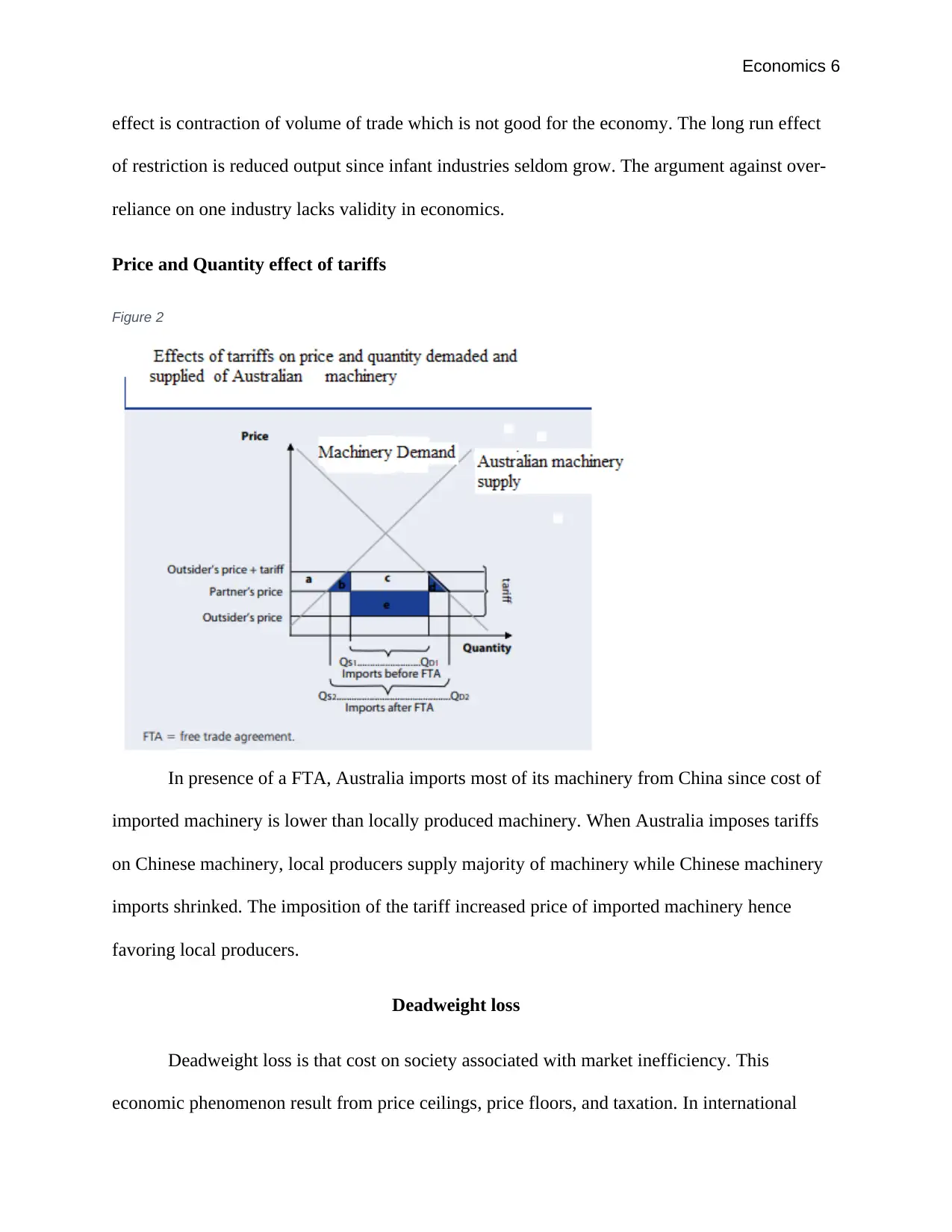
Economics 6
effect is contraction of volume of trade which is not good for the economy. The long run effect
of restriction is reduced output since infant industries seldom grow. The argument against over-
reliance on one industry lacks validity in economics.
Price and Quantity effect of tariffs
Figure 2
In presence of a FTA, Australia imports most of its machinery from China since cost of
imported machinery is lower than locally produced machinery. When Australia imposes tariffs
on Chinese machinery, local producers supply majority of machinery while Chinese machinery
imports shrinked. The imposition of the tariff increased price of imported machinery hence
favoring local producers.
Deadweight loss
Deadweight loss is that cost on society associated with market inefficiency. This
economic phenomenon result from price ceilings, price floors, and taxation. In international
effect is contraction of volume of trade which is not good for the economy. The long run effect
of restriction is reduced output since infant industries seldom grow. The argument against over-
reliance on one industry lacks validity in economics.
Price and Quantity effect of tariffs
Figure 2
In presence of a FTA, Australia imports most of its machinery from China since cost of
imported machinery is lower than locally produced machinery. When Australia imposes tariffs
on Chinese machinery, local producers supply majority of machinery while Chinese machinery
imports shrinked. The imposition of the tariff increased price of imported machinery hence
favoring local producers.
Deadweight loss
Deadweight loss is that cost on society associated with market inefficiency. This
economic phenomenon result from price ceilings, price floors, and taxation. In international
⊘ This is a preview!⊘
Do you want full access?
Subscribe today to unlock all pages.

Trusted by 1+ million students worldwide

Economics 7
trade, deadweight loss might motivate countries to enter in to free trade agreements especially
when local industries do not satisfy local demand in terms of quantity, price, and quality.
Q3. Fiscal policies are measures used by government in controlling price levels and economic
growth in the economy ( Avi-Yonah, & Clausing, 2017). It includes use of expansionary and
contractionary policies that have an effect of increasing and reducing money supply respectively.
Expansionary fiscal policies are employed during time of deflation in order to increase money
supply and foster economic growth and employment.
Altering amount of government expenditure has an impact of either increasing or
reducing inflation levels in the economy. Government is in most instances the greatest spender in
every country. Government expenditure affects gross domestic product and thus its increase
leads to a direct rise in GDP .The direction and size of its expenses have huge impact on
economic growth, and employment rates (McKeehan & Zodrow, 2017). Increased government
expenditure acts as an expansionary policy especially during times of deflation. The government
might allocate large amount of capital resources on infrastructure, health, education, agriculture,
and manufacturing industry with the aim of increasing money supply in the economy. Increased
state expenditure also causes an indirect increase in the level of consumption in the economy.
Taxation is a major fiscal policy used by governments in controlling the levels of
inflation. As an expansionary policy, governments reduces taxation. Reduction of taxes reduces
recessionary pressures in the economy (Kirschen & Strbac, 2018).It increases disposable income of
household’s hence increasing amount of money available for them to spend. Also, when
governments reduce taxes increases investor confidence and hence enhancing private investment
which increases the GDP. Governments might reduce taxation by reducing rates of taxation or by
trade, deadweight loss might motivate countries to enter in to free trade agreements especially
when local industries do not satisfy local demand in terms of quantity, price, and quality.
Q3. Fiscal policies are measures used by government in controlling price levels and economic
growth in the economy ( Avi-Yonah, & Clausing, 2017). It includes use of expansionary and
contractionary policies that have an effect of increasing and reducing money supply respectively.
Expansionary fiscal policies are employed during time of deflation in order to increase money
supply and foster economic growth and employment.
Altering amount of government expenditure has an impact of either increasing or
reducing inflation levels in the economy. Government is in most instances the greatest spender in
every country. Government expenditure affects gross domestic product and thus its increase
leads to a direct rise in GDP .The direction and size of its expenses have huge impact on
economic growth, and employment rates (McKeehan & Zodrow, 2017). Increased government
expenditure acts as an expansionary policy especially during times of deflation. The government
might allocate large amount of capital resources on infrastructure, health, education, agriculture,
and manufacturing industry with the aim of increasing money supply in the economy. Increased
state expenditure also causes an indirect increase in the level of consumption in the economy.
Taxation is a major fiscal policy used by governments in controlling the levels of
inflation. As an expansionary policy, governments reduces taxation. Reduction of taxes reduces
recessionary pressures in the economy (Kirschen & Strbac, 2018).It increases disposable income of
household’s hence increasing amount of money available for them to spend. Also, when
governments reduce taxes increases investor confidence and hence enhancing private investment
which increases the GDP. Governments might reduce taxation by reducing rates of taxation or by
Paraphrase This Document
Need a fresh take? Get an instant paraphrase of this document with our AI Paraphraser
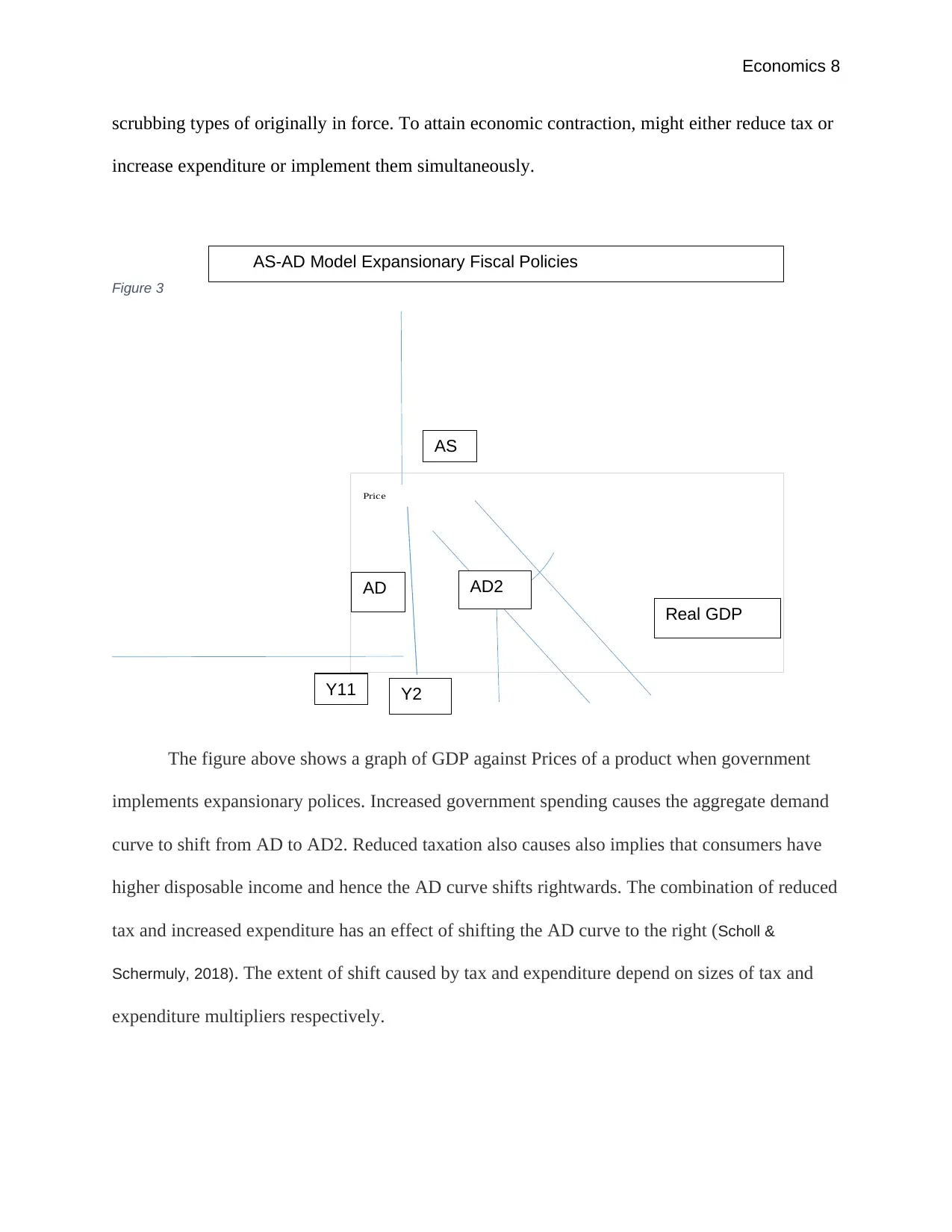
Economics 8
scrubbing types of originally in force. To attain economic contraction, might either reduce tax or
increase expenditure or implement them simultaneously.
Figure 3
P2
P1
Price
The figure above shows a graph of GDP against Prices of a product when government
implements expansionary polices. Increased government spending causes the aggregate demand
curve to shift from AD to AD2. Reduced taxation also causes also implies that consumers have
higher disposable income and hence the AD curve shifts rightwards. The combination of reduced
tax and increased expenditure has an effect of shifting the AD curve to the right (Scholl &
Schermuly, 2018). The extent of shift caused by tax and expenditure depend on sizes of tax and
expenditure multipliers respectively.
Y11 Y2
AS
AD
AS-AD Model Expansionary Fiscal Policies
AD2
Real GDP
scrubbing types of originally in force. To attain economic contraction, might either reduce tax or
increase expenditure or implement them simultaneously.
Figure 3
P2
P1
Price
The figure above shows a graph of GDP against Prices of a product when government
implements expansionary polices. Increased government spending causes the aggregate demand
curve to shift from AD to AD2. Reduced taxation also causes also implies that consumers have
higher disposable income and hence the AD curve shifts rightwards. The combination of reduced
tax and increased expenditure has an effect of shifting the AD curve to the right (Scholl &
Schermuly, 2018). The extent of shift caused by tax and expenditure depend on sizes of tax and
expenditure multipliers respectively.
Y11 Y2
AS
AD
AS-AD Model Expansionary Fiscal Policies
AD2
Real GDP
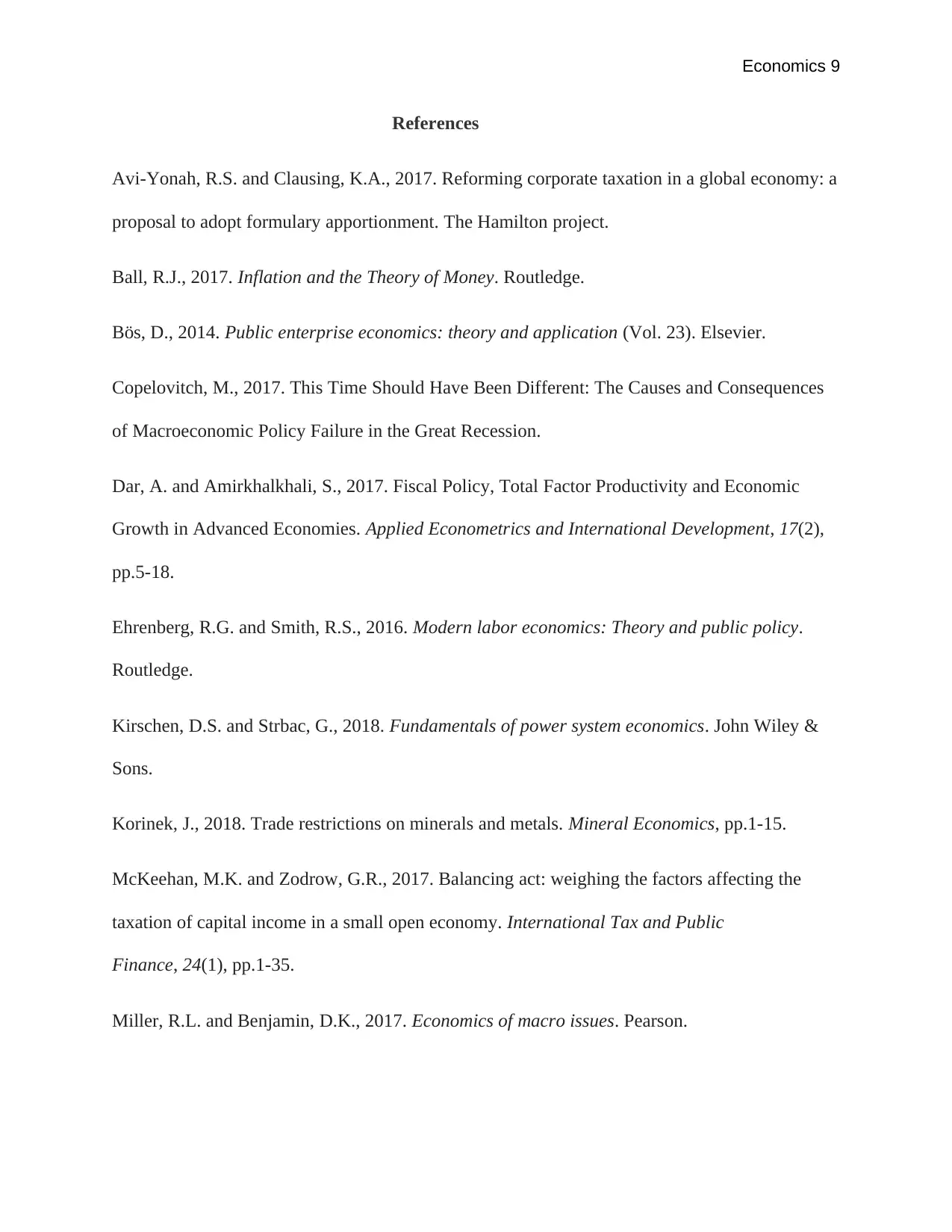
Economics 9
References
Avi-Yonah, R.S. and Clausing, K.A., 2017. Reforming corporate taxation in a global economy: a
proposal to adopt formulary apportionment. The Hamilton project.
Ball, R.J., 2017. Inflation and the Theory of Money. Routledge.
Bös, D., 2014. Public enterprise economics: theory and application (Vol. 23). Elsevier.
Copelovitch, M., 2017. This Time Should Have Been Different: The Causes and Consequences
of Macroeconomic Policy Failure in the Great Recession.
Dar, A. and Amirkhalkhali, S., 2017. Fiscal Policy, Total Factor Productivity and Economic
Growth in Advanced Economies. Applied Econometrics and International Development, 17(2),
pp.5-18.
Ehrenberg, R.G. and Smith, R.S., 2016. Modern labor economics: Theory and public policy.
Routledge.
Kirschen, D.S. and Strbac, G., 2018. Fundamentals of power system economics. John Wiley &
Sons.
Korinek, J., 2018. Trade restrictions on minerals and metals. Mineral Economics, pp.1-15.
McKeehan, M.K. and Zodrow, G.R., 2017. Balancing act: weighing the factors affecting the
taxation of capital income in a small open economy. International Tax and Public
Finance, 24(1), pp.1-35.
Miller, R.L. and Benjamin, D.K., 2017. Economics of macro issues. Pearson.
References
Avi-Yonah, R.S. and Clausing, K.A., 2017. Reforming corporate taxation in a global economy: a
proposal to adopt formulary apportionment. The Hamilton project.
Ball, R.J., 2017. Inflation and the Theory of Money. Routledge.
Bös, D., 2014. Public enterprise economics: theory and application (Vol. 23). Elsevier.
Copelovitch, M., 2017. This Time Should Have Been Different: The Causes and Consequences
of Macroeconomic Policy Failure in the Great Recession.
Dar, A. and Amirkhalkhali, S., 2017. Fiscal Policy, Total Factor Productivity and Economic
Growth in Advanced Economies. Applied Econometrics and International Development, 17(2),
pp.5-18.
Ehrenberg, R.G. and Smith, R.S., 2016. Modern labor economics: Theory and public policy.
Routledge.
Kirschen, D.S. and Strbac, G., 2018. Fundamentals of power system economics. John Wiley &
Sons.
Korinek, J., 2018. Trade restrictions on minerals and metals. Mineral Economics, pp.1-15.
McKeehan, M.K. and Zodrow, G.R., 2017. Balancing act: weighing the factors affecting the
taxation of capital income in a small open economy. International Tax and Public
Finance, 24(1), pp.1-35.
Miller, R.L. and Benjamin, D.K., 2017. Economics of macro issues. Pearson.
⊘ This is a preview!⊘
Do you want full access?
Subscribe today to unlock all pages.

Trusted by 1+ million students worldwide

Economics 10
Ottonello, P., Presno, I. and Bianchi, J., 2017. Fiscal Policy, Sovereign Risk, and
Unemployment. In 2017 Meeting Papers(No. 1382). Society for Economic Dynamics.
Scholl, W. and Schermuly, C.C., 2018. The Impact of Culture on Corruption, Gross Domestic
Product, and Human Development. Journal of Business Ethics, pp.1-19.
Ottonello, P., Presno, I. and Bianchi, J., 2017. Fiscal Policy, Sovereign Risk, and
Unemployment. In 2017 Meeting Papers(No. 1382). Society for Economic Dynamics.
Scholl, W. and Schermuly, C.C., 2018. The Impact of Culture on Corruption, Gross Domestic
Product, and Human Development. Journal of Business Ethics, pp.1-19.
1 out of 10
Related Documents
Your All-in-One AI-Powered Toolkit for Academic Success.
+13062052269
info@desklib.com
Available 24*7 on WhatsApp / Email
![[object Object]](/_next/static/media/star-bottom.7253800d.svg)
Unlock your academic potential
Copyright © 2020–2026 A2Z Services. All Rights Reserved. Developed and managed by ZUCOL.





